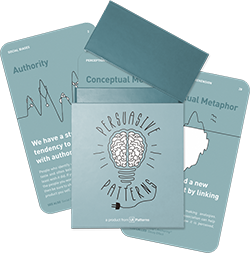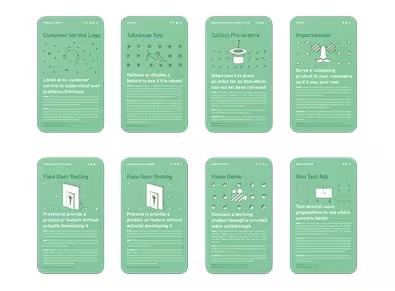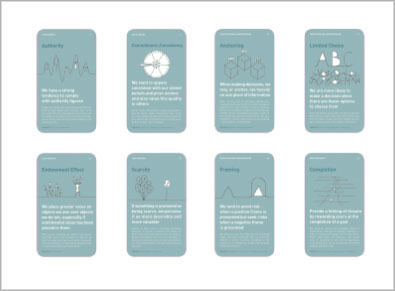Retaliation
Design Pattern
Alternate titles: Revenge, Negative Reciprocity.
Problem summary
People repay in kind
Usage
- Use when revenge can be encouraged to enforce positive and playful play; to beat friends in games or challenges.
- Use to curate the quality of your user generated content, weeding out misfits or harmful content or users.
- Do not use when the act of revenge will end in a combative feud where only one winner remains with a joyful memory
This card is part of the Persuasive Patterns printed card deck
The Persuasive Patterns Card Deck is a collection of 60 design patterns driven by psychology, presented in a manner easily referenced and used as a brainstorming tool.
Get your deck!Solution
- Give before you ask. Demonstrate the value you have to offer before asking users to convert into paying customers. Asking too early can backfire into bad reputation. Start by giving before taking in order to get users to reciprocate.
- Build a relationship first. Asking before providing trust in your intentions can create suspicion and make users reluctant to cooperate.
- Don’t be evil. The negative emotional value of a transactional loss of $100 is at least twice as much as the positive emotional value of a $100 gain. Acts of retaliation also tend to be equally larger than acts of positively giving back.
Rationale
If we feel we have been treated unfairly, we have an urge to want everyone else to know what that person did to us. Loss Aversion plays into this, as we perceive the value of a loss much greater than we do with gains and thus reciprocate more with anger than with joy.
Retaliation refers to the inherent human tendency to respond to actions in a manner that mirrors the nature of the original action, be it positive or negative.
At its core, retaliation is deeply rooted in the principle of reciprocity, but with a focus on responding to perceived slights or negative actions. While reciprocity typically emphasizes the positive cycle of giving and receiving, retaliation underscores the human desire to “settle the score” when treated unfairly or negatively. This pattern can influence decisions, behaviors, and overall experiences with products or services. However, when tapping into this pattern, it’s crucial to approach it with care, ensuring that interactions foster a positive user experience and do not instigate negative behaviors or feelings.
The principle underlying retaliation is rooted in the fundamental human desire for fairness and justice. When individuals perceive that they have been treated unfairly, they often respond with actions intended to “balance the scales.” This drive for equity is deeply embedded in human psychology and can be observed across cultures and contexts.
Retaliation is intricately linked to the principle of Loss Aversion. The pain of a loss (or perceived slight) is often felt more acutely than the pleasure of a gain. This is especially true for retaliation, or negative reciprocity, which carries more emotional weight than positive reciprocity. The urge to “set things right” after feeling wronged often outweighs the potential benefits of letting go or responding with generosity.
Discussion
If users feel a product is taking more from them (in terms of data, time, or resources) without matching in given value, they might ‘retaliate’ by leaving negative reviews, discontinuing use, or advocating against the product in their networks.
Retaliation is often the result, when businesses are not fair, honest, or engage in manipulative and unethical design practices. Designers have a responsibility to ensure that the exchange between the user and the product is always perceived as fair. When users invest time, data, or any other form of commitment, they should feel they are getting equivalent or higher value in return. This balance can be reinforced by timely rewards, acknowledgments, or enhanced features.
When designing features that play on the users’ need for retaliation, it’s essential to ensure they are not abused and that they always serve a legitimate purpose. The goal should not be to promote negativity but to allow users a fair way to express dissatisfaction or protect their interests. Ethical considerations must be at the forefront to ensure users’ actions are justified and not simply vindictive. Companies should ensure that such features are not abused and that there are checks and balances in place to prevent misuse.
While negative reciprocation is powerful, it’s crucial to balance it with mechanisms for positive feedback. This ensures that users are not always in a negative feedback loop and can also appreciate and reward good behavior or content. If a retaliation or feedback mechanism is implemented, set clear guidelines on its use. This can prevent misuse and ensure that retaliation is used constructively.
Especially in platforms where user-generated content is dominant, combining retaliation mechanisms with moderation tools can help in maintaining the quality and positivity of content. Ensure that users are aware of the implications of retaliation mechanisms, how they work, and the potential consequences. This can prevent misuse and foster a more informed and responsible user community.
Not all products or services are suitable for integrating a retaliation mechanism. It’s essential to understand the user base, the context of use, and the potential implications of adding such a feature.
Powerful pairings
The Retaliation pattern has the potential to be combined with other persuasive patterns for more effective outcomes. Here are a few combinations:
- Retaliation + Social Proof. People often look to others to decide how to react or behave. If a product or service allows users to see how others are reacting, especially in retaliation to negative behaviors, it may amplify the effect. For example, on platforms like Reddit, users downvote inappropriate or irrelevant content. When others see a comment with many downvotes, they may be more likely to downvote as well, reinforcing the negative feedback loop.
- Retaliation + Commitment & Consistency. Once users take a stand or position, they tend to remain consistent with it. If a platform offers a way for users to publicly retaliate or express their dissatisfaction, these users might stick to their position more adamantly in the future. An example would be a user leaving a negative review on a product; they are less likely to change their viewpoint even if the issue is resolved later.
- Retaliation + Reputation. A user’s reputation can be influenced by their actions and the reactions (including retaliation) of others. On platforms like eBay, for instance, both buyers and sellers are wary of negative feedback as it directly impacts their reputation.
Ethical Recommendations
One primary concern with allowing retaliation is the pitfall of creating a toxic environment or to unfairly target certain users. For instance, allowing users to collectively downvote or retaliate against a particular user or viewpoint could lead to groupthink, where minority opinions are suppressed. Additionally, without proper safeguards, the retaliation mechanism can be weaponized for personal vendettas, cyberbullying, or to serve vested interests. Lastly, overemphasis on negative feedback can create a hostile environment, deterring new users and demotivating existing ones.
- Implement safeguards. Introduce measures to prevent the misuse of the retaliation mechanism. For example, limit the frequency of negative feedback a user can give within a specific timeframe or introduce cooldown periods.
- Monitor and moderate. Regularly monitor user interactions, especially where retaliation mechanisms are employed. Consider implementing automated systems to flag potential misuse and ensure human oversight for critical decisions.
- Educate the user base. Make users aware of the purpose of the retaliation feature and the importance of using it responsibly. Encourage constructive feedback over mere negative reactions.
- Balance with positive interactions. While allowing for negative reciprocation, always ensure there are avenues for positive interactions. This balance can prevent the environment from becoming overly negative.
- Transparency. If a user is on the receiving end of retaliation actions, ensure they have a clear understanding of why it happened and provide avenues for redress or appeal.
Ethical use of the Retaliation pattern requires a deep understanding of human behavior and a commitment to user welfare. By ensuring a balance between allowing users to express dissatisfaction and preventing misuse, platforms can benefit from the genuine feedback while safeguarding the user community’s health and well-being.
Retaliation is negative reciprocity. Fehr and Gächter showed that, when acting within reciprocal frameworks, individuals are more likely to deviate from purely self-interested behavior than when acting in other social contexts. Treachery is often repaid with disproportionate amounts of hostility and vengeance.
1 Fehr and Gächter (2000). “Fairness and Retaliation: The Economics of Reciprocity”. Journal of Economic Perspectives. 14 (3): 159–182.
2 Smith, J. & Doe, A. (1985). The dynamics of negative reciprocity in interpersonal relationships. Journal of Social Psychology, 45(2), 123-135.
3 B. Brosnan, S. F., & De Waal, F. B. (2003). Monkeys reject unequal pay. Nature, 425(6955), 297-299.
4 Johnson, T. & White, L. (1990). The psychology of retaliation in interpersonal contexts. Behavioral Science Quarterly, 10(4), 56-70.
5 Perez, M. & Lee, H. (2000). Negative reciprocity and its impact on consumer behavior. Consumer Psychology Journal, 5(1), 20-30.
6 Gouldner, A. W. (1960). The norm of reciprocity: A preliminary statement. American sociological review, 25(2), 161-178.
7 Kahneman, D., & Tversky, A. (1979). Prospect theory: An analysis of decision under risk. Econometrica, 47(2), 263-291.
8 Retaliation persuasive effect at Learning Loop
User Interface Design Patterns
- Forms
- Explaining the process
- Community driven
- Tabs
- Jumping in hierarchy
- Menus
- Content
- Gestures
- Tables
- Formatting data
- Images
- Search
- Reputation
- Social interactions
- Shopping
- Increasing frequency
- Guidance
- Registration
Persuasive Design Patterns
- Loss Aversion
- Other cognitive biases
- Scarcity
- Gameplay design
- Fundamentals of rewards
- Gameplay rewards


